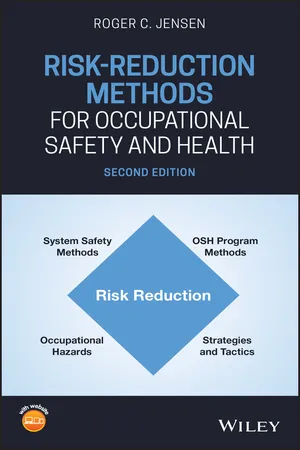
- English
- ePUB (mobile friendly)
- Available on iOS & Android
Risk-Reduction Methods for Occupational Safety and Health
About this book
Provides a thorough overview of systematic methods for reducing risks encountered in diverse work places
Filled with more theory, numerous case examples, and references to new material than the original text, this latest edition of a highly acclaimed book on occupational safety and health includes substantial updates and expanded material on management systems, risk assessment methods, and OSH-relevant concepts, principles, and models.
Risk-Reduction Methods for Occupational Safety and Health is organized into five parts: background; analysis methods; programmatic methods for managing risk; risk reduction for energy sources; and risk reduction for other than energy sources. It comprehensively covers both system safety methods and OSH management methods applicable to occupational health and safety. Suitable for worldwide applications, the author's approach avoids reliance on the thousands of rules, codes, and standards by focusing on understanding hazards and reducing risks using strategies and tactics.
- Includes more content on methods for reducing risks, citations of recent research, and deeper coverage of OSH-relevant concepts, theories, and models
- Merges methods and principles traditionally associated with occupational hygiene, ergonomics, and safety
- Provides substantial updates on management systems and theories of occupational incidents, and includes new case studies in many chapters to help demonstrate the "real world" need for identifying and implementing risk-reduction strategies
- Addresses occupational risks that go beyond current regulations and standards, taking an international approach by stressing risk-reduction strategies
- Supports adoption of the book for university courses by providing chapter-specific learning exercises and support materials for professors
Risk-Reduction Methods for Occupational Safety and Health is ideal for safety professionals, system safety engineers, safety engineers, industrial hygienists, ergonomists, and anyone with OSH responsibilities. It is also an excellent resource for students preparing for a career in OSH.
Frequently asked questions
- Essential is ideal for learners and professionals who enjoy exploring a wide range of subjects. Access the Essential Library with 800,000+ trusted titles and best-sellers across business, personal growth, and the humanities. Includes unlimited reading time and Standard Read Aloud voice.
- Complete: Perfect for advanced learners and researchers needing full, unrestricted access. Unlock 1.4M+ books across hundreds of subjects, including academic and specialized titles. The Complete Plan also includes advanced features like Premium Read Aloud and Research Assistant.
Please note we cannot support devices running on iOS 13 and Android 7 or earlier. Learn more about using the app.
Information
Part I
Background
Chapter 1
Contributions to Occupational Safety and Health
1.1 CONTRIBUTIONS BY LAW MAKERS
1.1.1 OSH‐Related Laws

1.1.2 Workers' Compensation Laws
Table of contents
- Cover
- Table of Contents
- Preface
- Acknowledgments
- About the Companion Website
- Part I: Background
- Part II: Analysis Methods
- Part III: Programmatic Methods for Managing Risk
- Part IV: Risk Reduction for Energy Sources
- Part V: Risk Reduction for Other Than Energy Sources
- Index
- End User License Agreement